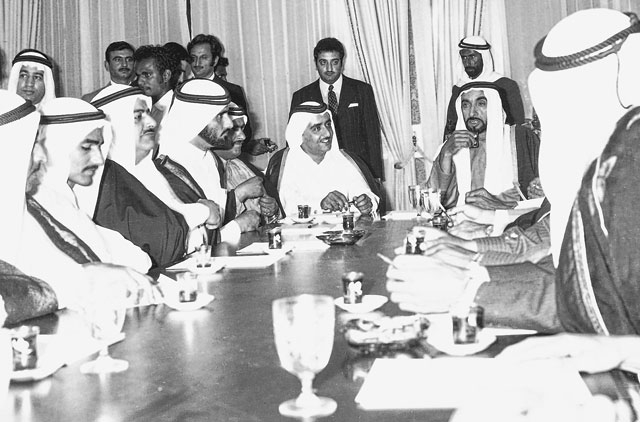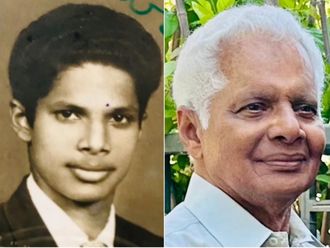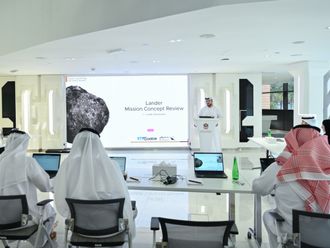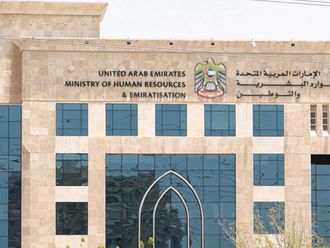
Abu Dhabi: The UAE is 40 years young. The bright idea that flashed through the mind of a visionary leader and came to be realised 40 years ago continues to shine today lighting the way for an advanced economic and political powerhouse — the UAE.
The march towards the nation's development and advancement was launched on December 2, 1971, led by the late Shaikh Zayed Bin Sultan Al Nahyan, the founder of the union, and was taken up by his son, President His Highness Shaikh Khalifa Bin Zayed Al Nahyan. The story dates back to February 1968 when Shaikh Zayed met with the then ruler of Dubai, Shaikh Rashid Bin Saeed Al Maktoum, to discuss border disputes.
This was followed by the signing of an agreement on February 27, 1968, which would form a federation of nine emirates (Abu Dhabi, Dubai, Sharjah, Ajman, Umm Al Quwain, Fujairah, Ras Al Khaimah, Bahrain and Qatar).
Unfortunately, they had many setbacks as Shaikh Zayed tried for three years to bring things together — Bahrain and Qatar sought full independence and Ras Al Khaimah also declined to join.
Initial days
On December 2, 1971, a federation of six emirates (Abu Dhabi, Dubai, Sharjah, Ajman, Umm Al Quwain and Fujairah) formed the United Arab Emirates (UAE). Shaikh Zayed was elected president and Shaikh Rashid was elected vice-president. Ras Al Khaimah decided to join the federation officially on February 10, 1972.
On this occasion, Gulf News celebrates this glorious event and its coverage will enable UAE citizens to refresh their memories with stories of development and how the UAE has been evolving in the past 40 years.
This will also allow our readers to share their experiences and express their comments on the achievements of the past 40 years.
To mark the special 40 years, the nation-wide celebrations will start today, 40 days before the special celebrations on December 2, 2011.
Accounts from people who have lived through the Federation will help reflect on historic moments.
Looking at the past 40 years will give Emiratis strength, will and persistence to continue marching ahead, and give them greater faith in the unity that led to their advancement and achievement of their aspirations.
The country's achievements were the result of efforts of great and loyal men and today's challenges are maintaining the successes and achievements in a fast-paced world of fierce competition.
Shaikh Zayed's desire was that young Emiratis should always remember the difficult beginnings and, therefore, the collective responsibility of everybody to work towards preserving his vision. It is also the duty of Emiratis to take forward this vision of Shaikh Zayed which is being carried through by the new generation of leadership.
The UAE has been established on the world map. There are plans in place to focus on education as the main investment for the future. Shaikh Zayed started this in the 1960s, but Abu Dhabi's capabilities were then limited. That was the beginning. Today there are plans to make education truly competitive on a global scale. It is necessary to look at education not only as sending students to schools but as really helping them develop and train in all areas necessary for survival in the 21st century and carrying this project forward.
Looking back
- The beginning was a miraculous creation, a miraculous birth that brought into being a new state — the United Arab Emirates, with experts doubting the nascent country's very survival beyond a few months or years.
- 1966: Shaikh Zayed Bin Sultan Al Nahyan becomes Ruler of Abu Dhabi. The year also witnesses the establishment of a number of new administrative departments headed by members of the Al Nahyan Ruling Family and some prominent citizens.
- Beginning of 1968: Britain announces intention to withdraw from the Arabian Gulf by the end of 1971.
- 1970: Iran lays claim to the islands of Greater and Lesser Tunbs and Abu Mousa. The following year, Iran occupies the three islands. Since then, the UAE has been repeatedly calling for a peaceful resolution or the use of international arbitration to resolve the issue.
- December 2, 1971: Shaikh Zayed acts rapidly to initiate moves for closer ties among the Emirates. Along with Shaikh Rashid Bin Saeed Al Maktoum, then Ruler of Dubai, who was to become Vice-President and later Prime Minister of the newly formed state, Shaikh Zayed takes the lead in calling for the formation of a federation that would include the seven emirates that together made up the Trucial States, and Qatar and Bahrain.
- Following a period of negotiation, however, agreement is reached among the Rulers of Emirates (Abu Dhabi, Dubai, Sharjah, Ajman, Umm Al Quwain and Fujairah) and the federation to be known as the United Arab Emirates (UAE) which is formally established on December 2, 1971 with Shaikh Zayed as President.
- The UAE adopts a provisional constitution intended to expire after five years but it was renewed until the adoption of a permanent constitution in 1996.
- The UAE joins the Arab League.
- February 10, 1972: The seventh emirate, Ras Al Khaimah, formally accedes to the new federation.
- 1976: The government centralises further as the federal government attains control over defence, intelligence services, immigration, public security, and border control.












